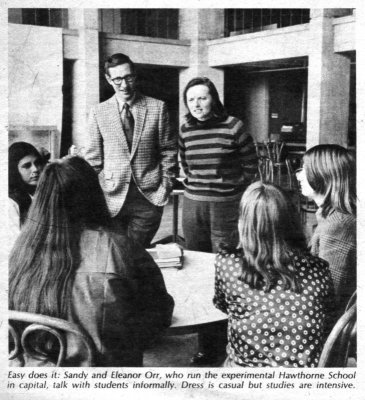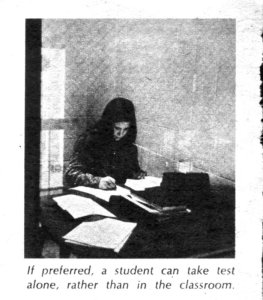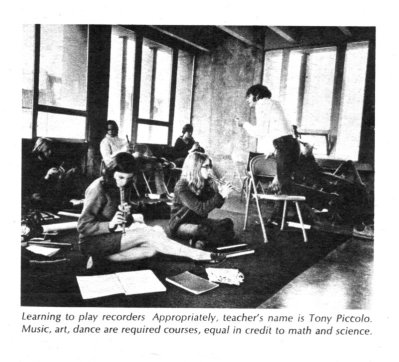The Hawthorne School
Washington, D.C.
|
|
|
|
|
|
![]()
The Hawthorne School
Washington, D.C.
Parade Magazine, January 18, 1970
David Mitchell (one of Howie Mitchell's sons) transcribed the
following article about Hawthorne from Parade Magazine, January 18,
1970, and provided scans of the illustrations. Click on any of
the illustrations for a larger version.
 A few blocks from the
U.S. Capitol is one of the country’s most unconventional and
untroubled high schools.
A few blocks from the
U.S. Capitol is one of the country’s most unconventional and
untroubled high schools.
Hawthorne School is private. But unlike most private schools, admission is not based on I.Q. tests or grades. In fact, this academically superior school chooses to include public high school students labeled as “fringe students,” “problem children” or outright “academic failures.”
“For many parents, we’re the last resort before their kids drop out of school and society. It is usually a big surprise to people that 96-98 percent of our students end up in highly competitive colleges,” say Sandy and Eleanor Orr, a married couple with four children, who started the Hawthorne experiment 13 years ago.
Today, increasing numbers of public high school teachers and principals are observing in Hawthorne classes, hoping to discover how an entire student body can be engaged in intellectual pursuits far more demanding than what is expected in average schools today. Moreover, they are looking for clues as to why many once apathetic or belligerent students turn into productive ones.
What they find is that Hawthorne looks like Alice’s Restaurant and the student body treats the Orrs like the Ray and Alice of the educational world. Everybody is on a first-name basis. There are few rules, no “study halls,” bag lunches. Long before dress codes were relaxed in other high schools, Hawthorne students were grooving in and out of classes in mini-maxi-granny clothes, Army jackets, tights, sandals, beards and long, flowing hair.
But top educators like Canon Charles Martin, headmaster of Washington’s estimable St. Albans School, tell parents to discount Hawthorne’s freaky externals and look instead at its record of educational excellence.
“Its an extraordinary school for extraordinary times,” says Canon Martin. “The Orrs really know how to listen carefully to students who have turned off and give back to them material that means something.”
Eleanor Orr, an intense, husky-voiced math and science teacher, says: “Our biggest problem today is convincing young people that there is plenty of room to move in this world, that it isn’t all full up out there.”
To do this, the Orrs
depend on students to help create their own curriculum. And what the
young people opt for is not sugar-coated information, but
high-powered, intellectually rigorous, college-level reasoning. They
like it very tough. And they do well.
“To succeed here, you have to develop a high degree of concentration and devote a lot of time to learning,” says Kathy Snyder, who found the discipline and boredom of public high school unbearable. Stimulated at Hawthorne, she recently earned a commendation from the National Merit Scholarship Corporation.
The Orrs have worked out an unusual trimester system of intensive study in only two major subjects at a time. It seems to draw out all kinds of hidden resources the students don’t know they have. And most love it.
“They don’t divide you up in compartments here,” says Doug Dickey. “There’s just no time for a lot of little busy work. We go deep into things.”
Often this means working right through 2½-hour-long classes conducted by a faculty less interested in educational theory than in learning along with their pupils.
Science teacher “Howie” Mitchell, for example, says that each year his understanding of the nature of science deepens as a result of his students’ canny interpretations of natural phenomena. He uses no texts, requiring students to proceed like any scientist. First, they invent for themselves hypothetical explanations for what they see, hear and feel. Then they test the validity of their hypotheses by using the data of the entire class and by devising their own experiments. Only after these difficult steps do they study the work of the great scientists.
“When we are the science textbook, everybody in the class needs information from the other person,” explains Eve Applebaum. “Knowing that so much depends on you makes it worthwhile to knock yourself out.”
In English, instead of a single, traditional course, Hawthorne students take separate classes from different teachers in literature and composition. And they draw up their own reading lists. On Halloween, for instance, the literature seminar called for all students to read science fiction and fantasy, after which there was an all-day, school-wide analysis of the physics, philosophy and history of the real and the unreal – including illusions, auras, mystics, clairvoyants and the zodiac.
In mathematics, students are required to take geometry before algebra to help them realize that math is simply a form of argument and that all reasoning starts with arbitrary assumptions and definitions.
“A long time ago, when I was teaching younger children, it hit me like a lead zeppelin that my students really needed to know why, for instance, they were supposed to invert the divisor. So I spent night after night cutting up paper to show them why in concrete terms.” Eleanor Orr explains. “Now we try to help high school students overcome the powerlessness of being forced to accept as fact conclusions made by somebody else.”
In the Orrs’ home at night, the lives of such men as Da Vinci, Marx, Gandhi and Sun Yat-sen are discussed by seniors. The idea is to teach college-bound youths to discriminate between instant, pseudo-sophisticated opinions – and accurate viewpoints, value judgments and interpretations. A byproduct seems to be super-sharp awareness of what is going on in the world today.
“It’s not at all far out for us to argue about the Delphic Oracle in ancient Greece and the way people think about God in America today. Sandy and Eleanor make us question everything,” says Steve Hoyt.
“The harder you have to work, the better you get at it,” says Kathy Snyder. “I’m not really worried about college. We’ve been using some college textbooks at Hawthorne since the tenth grade.”
Long before most colleges were hit with student protests for “relevancy” in courses, Hawthorne students in all grades were grappling with the results of their own demands for a curriculum that reflected America today. They asked for – and got – a very hard, one shot course in Negro, Jewish, Irish and Establishment culture, the only subject offered for a trimester.
 “We are always
listening, doing and swapping with students,” says Sandy Orr, 45, a
Williams graduate. “And we sense that kids today cover up their
alienation with slick words. So this year we are giving them
non-verbal courses which we think will enable them to become
conscious of their own feelings in a more accurate way.”
“We are always
listening, doing and swapping with students,” says Sandy Orr, 45, a
Williams graduate. “And we sense that kids today cover up their
alienation with slick words. So this year we are giving them
non-verbal courses which we think will enable them to become
conscious of their own feelings in a more accurate way.”
Therefore, art and
music are required and dance receives equal credit with math and
science. Every student in the school is learning to play the
recorder. In fact, seniors have been told they must read music if
they expect to graduate.
“In this school,
non-verbal work in music, art and dance is considered as fundamental
to education as training in verbal skills,” says 29-year-old dance
teacher, Sally Nash. “You can’t get by mouthing a lot of verbiage
about what you are achieving. It’s what you are doing that
counts.”
She has structured
a “problem-solving” dance curriculum so that individual styles of
movement will emerge. Boys and girls alike are required to practice
yoga for flexibility, long-distance running for endurance, hill
climbing for balance and folk dances for awareness of rhythm.
Art teacher Dante Radice says: “We don’t bend standards in teaching the basic academic truths. But we are very, very free to experiment.” He is a self-described “old-fashioned” art teacher where line, form, color and texture are concerned. For instance, his art majors must study anatomy – but they may do so in dance lessons developed to help them explore the balance, weight and structure of each others’ bodies.
Hawthorne has an
annual Poetry Week, during which such well known poets as Louis
Untermeyer and Howard Nemerov share with students experiences on
writing poetry. The entire faculty participates. One week ended with
poets and teachers reading poems in Hebrew, French, German, Gaelic,
Spanish and Russian to a young audience by then so sensitive to
rhythms and sounds that they did not even ask for translations.
What is it about the
school that responds to the needs of a diverse, troubled, questing
youth? Mary Chancellor, daughter of NBC’s John Chancellor, who
graduated last year, puts it this way: “it sounds corny to talk
about caring for your environment. But I never cared for my own
school or other important things in the world until I went to
Hawthorne.”
April Fish, a pretty blonde who wears lace stockings, boots and a feathered felt hat, says: “There’s something about being trusted to learn. And being perfectly certain that it’s your own hard luck if you bum out.”
How does Hawthorne
maintain its exacting academic standard in such an untraditional,
free-wheeling atmosphere? The Orrs’ answer is: “We are here to
educate people, not to police kids. This is a community. And we
respect each other.”
This
site contains material which may be copyrighted by others ("Material"),
the use of which has not been specifically authorized by the copyright
owner, if any. We are making such Material available for non-profit
educational purposes, and for the purpose of one or more of (a)
comment, (b) news reporting, (c) teaching, (d) scholarship and/or (e)
research. We believe this constitutes a 'fair use' of such Material as
provided for in Section 107 of the U.S. Copyright Laws. For more
information on Section 107, go to: http://www.law.cornell.edu/uscode/17/107.shtml.
If you wish to use any such Material for purposes that do not
constitute 'fair use', you must first obtain permission from the
copyright owner.